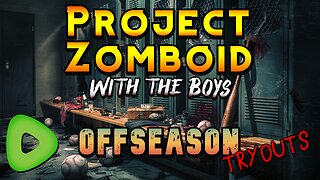Premium Only Content

WW2 color footage Tiger I Ausf. E. Panzerkampfwagen 6.
Originally uploaded 5 nov. 2021.
Footage is all AI colorized by computers and actual color footage was extremely rare in 1940-45.
The Tiger I was a German heavy tank developed in 1937 by Henschel & Sohn when the Waffenamt requested Henschel to develop a Durchbruchwagen, this would result into the Durchbruchwagen I
which would never be fitted with a turret and was replaced by the Durchbruchwagen II after the request for a heavier 30-tonne class vehicle with thicker armour.
The project was dropped in 1938 in favor of the larger and better-armoured VK 30.01 (H) and VK 36.01 (H), these vehicles would use the complex over-engineered Schachtellaufwerk track suspension system of torsion bar-sprung, overlapped and interleaved main road wheels, which would later become problematic when jamming solid in the winter.
Four prototype hulls were completed for testing. Two of these were later modified to build the "Sturer Emil" self-propelled anti-tank guns.
In 1941 with the experience of the Battle of France, Henschel and Ferdinand Porsche were asked to submit designs for a 45-tonne heavy tank, to be ready by June 1942. Porsche worked on an updated version of their VK 30.01 (P) Leopard tank prototype while Henschel worked on an improved VK 36.01 (H) tank. Henschel built two prototypes: a VK 45.01 (H) H1 with an 8.8 cm L/56 cannon, and a VK 45.01 (H) H2 with a 7.5 cm L/70 cannon.
Porsche and Henschel submitted prototype designs, each making use of the Krupp-designed turret. The Henschel design was accepted, mainly because the Porsche VK 4501 (P) prototype design used a troubled petrol-electric transmission system.
Production of the Panzerkampfwagen VI Ausf. H began in August 1942.
The tank was given its nickname "Tiger" by Ferdinand Porsche, and the Roman numeral was added after the Tiger II entered production.
The initial designation was Panzerkampfwagen VI Ausführung H was re-designated as PzKpfw VI Ausf. E in March 1943.
The Tiger was still at the prototype stage when it was first hurried into service, and therefore changes both large and small were made throughout the production run. A redesigned turret with a lower cupola was the most significant change. To cut costs, the river-fording submersion capability and an external air-filtration system were dropped.
It would first see action near Leningrad on 23 Sep. 1942 months earlier than had been planned. A platoon of 4 Tigers went into action, they could not operate in swampy, forested terrain, their movement was largely confined to roads and tracks, also many of these early models were plagued by problems with the transmission and many broke down, the Soviets also captured one Tiger largely intact, it enabled the Soviets to study the design and prepare countermeasures.
In the North African Campaign, the Tiger I first saw action during the Tunisian Campaign on 1 December 1942 east of Tebourba. The tanks proved that they had excellent protection from enemy fire, this greatly increased the crews trust in the quality of the armour, the crews also found the tank to be spacious and comfortable.
The Tiger proved to have great armament and was a outstanding design for its time, its armour which was resistant to tank and anti-tank guns of the time. and the 88 could knock out enemy Sherman tanks at 2,100 m and the T-34 at 1500 m, but with Allied tanks becoming more up-armored and upgraded and having better guns like the M3 90 mm cannon used on the M36 tank destroyer, made the Tiger vastly obsolete in the end.
The Tiger was also over-engineered using expensive materials and labor-intensive production methods, it was prone track failures and breakdowns and was limited in range by its high fuel consumption. It was also hard to transport and was often too heavy for small bridges which had 35 ton weight limits.
Still it was superior to its early contemporaries, and despite the low number produced, shortages in qualified crew and the considerable fuel requirement, it had a large impact in the war with Tigers destroying at least 10,300 enemy tanks, and 11,380 AT guns and artillery pieces in WW2. This was achieved for the loss of 1,725 Tigers.
-
 4:46
4:46
PANZER Insight
1 year agoWW2 Light Tank M3A1 Satan - Stuart - Color Footage.
94 -
 14:15
14:15
This Bahamian Gyal
20 hours agoDC server REFUSED to serve Donald TRUMP, then THIS happened . . .
32.6K24 -
 13:47
13:47
MichaelBisping
14 hours agoBISPING Reacts: "Tyson Fury will RETIRE and F&$K UP USYK?!" | Usyk vs Fury 2
10K7 -
 14:15
14:15
Tactical Advisor
14 hours agoNew Ruger Glock Clone | Magpul RXM (FIRST LOOK)
77K32 -
 7:55
7:55
The Nima Yamini Show
21 hours agoWho Is Controlling Facebook and Instagram? The Truth About George Soros and Meta’s Oversight Board
57.5K81 -
 3:45
3:45
BIG NEM
13 hours agoDiscover Your Ikigai: Finding Your Ultimate Purpose
66.3K3 -
 13:19
13:19
Dermatologist Dr. Dustin Portela
1 day ago $8.83 earnedDo You Have Sebaceous Filaments or Blackheads?
44.6K3 -
 2:21:35
2:21:35
Price of Reason
17 hours agoThe Establishment WORRIES about Elon Musk AGAIN! Superman Trailer Discussion! Sonic 3 Review!
65.6K3 -
 1:14:54
1:14:54
Steve-O's Wild Ride! Podcast
20 hours ago $28.47 earnedZac Brown Reveals The Secrets To HIs Success - Wild Ride #247
113K15 -
 4:16:43
4:16:43
JdaDelete
14 hours ago $16.83 earnedProject Zomboid with the Boys | The Great Boner Jam of 2025
70.8K